
This is a list of named geological features, except craters, on Ganymede, a moon of Jupiter. The list is complete as of August 2022.

This is a list of named geological features, except craters, on Ganymede, a moon of Jupiter. The list is complete as of August 2022.
| Name | Coordinates | Diameter (km) | Approval Date | Namesake | Refs |
|---|---|---|---|---|---|
| Enki Catena | 38°50′N13°52′W / 38.84°N 13.86°W | 160 | 1997 | Enki, Principal water god of the Apsu. | WGPSN |
| Khnum Catena | 32°54′N10°44′W / 32.90°N 10.73°W | 66 | 1997 | Khnum, Egyptian creation god. | WGPSN |
| Nanshe Catena | 15°24′N352°54′W / 15.4°N 352.9°W | 103.8 | 1997 | Goddess of springs and canals, daughter of Enki. | WGPSN |
| Terah Catena | 7°06′N277°36′W / 7.1°N 277.6°W | 283 | 2000 | Phoenician moon god who battled with Keret in Negeb. | WGPSN |
| Name | Coordinates | Diameter (km) | Approval Date | Namesake | Refs |
|---|---|---|---|---|---|
| Abydos Facula | 33°24′N153°24′W / 33.4°N 153.4°W | 180 | 1985 | Abydos, Egyptian town where Osiris was worshipped. | WGPSN |
| Akhmin Facula | 27°42′N189°30′W / 27.7°N 189.5°W | 245 | 1997 | Akhmim, Egyptian town where Min was worshipped. | WGPSN |
| Bigeh Facula | 29°00′N265°42′W / 29°N 265.7°W | 224 | 2000 | Bigeh, island where Hapi, Egyptian Nile god, resided. | WGPSN |
| Busiris Facula | 15°42′N215°24′W / 15.7°N 215.4°W | 369 | 1985 | Busiris, town in lower Egypt where Osiris was first installed as local god. | WGPSN |
| Buto Facula | 13°12′N203°30′W / 13.2°N 203.5°W | 245 | 1985 | Swamp where Isis hid Osiris' body. | WGPSN |
| Coptos Facula | 9°54′N209°12′W / 9.9°N 209.2°W | 329 | 1985 | Coptos, early town from which caravans departed. | WGPSN |
| Edfu Facula | 25°42′N147°06′W / 25.7°N 147.1°W | 184 | 1985 | Edfu, Egyptian town where Horus was worshipped. | WGPSN |
| Heliopolis Facula | 18°30′N147°12′W / 18.5°N 147.2°W | 50 | 1997 | Heliopolis, sacred Egyptian city of the sun. | WGPSN |
| Hermopolis Facula | 22°24′N195°18′W / 22.4°N 195.3°W | 260 | 1997 | Hermopolis, place where Unut was worshipped. | WGPSN |
| Memphis Facula | 14°06′N131°54′W / 14.1°N 131.9°W | 361 | 1985 | Memphis, ancient capital of lower kingdom. | WGPSN |
| Siwah Facula | 7°00′N143°06′W / 7.0°N 143.1°W | 220 | 1985 | Siwa, oasis oracle of Zeus-Ammon; visited by Alexander. | WGPSN |
| Tettu Facula | 37°36′N161°12′W / 37.6°N 161.2°W | 189 | 1985 | Egyptian town where Hatmenit and Osiris were worshipped. | WGPSN |
| Thebes Facula | 7°06′N202°24′W / 7.1°N 202.4°W | 360 | 1985 | Thebes, ancient capital of upper kingdom. | WGPSN |
| Name | Coordinates | Diameter (km) | Approval Date | Namesake | Refs |
|---|---|---|---|---|---|
| Lakhamu Fossa | 11°36′S227°42′W / 11.6°S 227.7°W | 370 | 1985 | Dragon monster, or divine natural force produced by Apsu and Tiamat. | WGPSN |
| Lakhmu Fossae | 50°24′N128°00′W / 50.4°N 128.0°W | 3,700 | 1985 | Lahmu, dragon monster, or divine natural force produced by Apsu and Tiamat. | WGPSN |
| Zu Fossae | 38°30′N150°30′W / 38.5°N 150.5°W | 2,900 | 1985 | Anzû (Zu), dragon of chaos slain by Marduk. | WGPSN |
| Name | Coordinates | Diameter (km) | Approval Date | Namesake | Refs |
|---|---|---|---|---|---|
| Hammamat Patera | 24°14′S318°06′W / 24.23°S 318.1°W | 45 | 2015 | Wadi Hammamat in Egypt, associated with petroglyphs and ancient mining. | WGPSN |
| Hamra Patera | 77°21′S171°22′W / 77.35°S 171.37°W | 43 | 2015 | Wadi in Jordan, associated with red sandstone cliffs and ancient copper mines. | WGPSN |
| Musa Patera | 31°21′S188°28′W / 31.35°S 188.46°W | 69 | 2015 | Wadi Musa in Jordan, proximal to Petra archeological site. | WGPSN |
| Natrun Patera | 30°56′S183°16′W / 30.93°S 183.26°W | 37.5 | 2015 | Wadi El Natrun in Egypt, site of ancient monasteries, proximal to site of Antoine de Saint-Exupéry’s aircraft crash that inspired the novella “The Little Prince”. | WGPSN |
| Rum Patera | 30°40′S182°49′W / 30.66°S 182.82°W | 38 | 2015 | Wadi Rum in Jordan associated with travels of T. E. Lawrence, petroglyphs, and several Neolithic sites. | WGPSN |
| Yaroun Patera | 46°39′S142°09′W / 46.65°S 142.15°W | 96 | 2015 | Wadi Yaroun in Lebanon, Neolithic archaeological site. | WGPSN |
| Name | Coordinates | Diameter (km) | Approval Date | Namesake | Refs |
|---|---|---|---|---|---|
| Barnard Regio | 6°48′S11°36′W / 6.8°S 11.6°W | 3,200 | 1979 | Edward E.; American astronomer (1857-1923). | WGPSN |
| Galileo Regio | 45°N127°W / 45°N 127°W | 4,440 | 1979 | Galileo Galilei, Italian astronomer (1564-1642). | WGPSN |
| Marius Regio | 2°30′N187°42′W / 2.5°N 187.7°W | 4,940 | 1979 | Simon; German astronomer (1570-1624). | WGPSN |
| Melotte Regio | 12°00′S245°00′W / 12.0°S 245°W | 4,100 | 2013 | Philibert Jacques; British astronomer (1880-1961). | WGPSN |
| Nicholson Regio | 33°06′S6°24′W / 33.1°S 6.4°W | 3,900 | 1979 | Seth Barnes; American astronomer (1891-1963). | WGPSN |
| Perrine Regio | 34°N28°W / 34°N 28°W | 3,800 | 1979 | Charles D.; American astronomer (1867-1951). | WGPSN |
| Name | Coordinates | Diameter (km) | Approval Date | Namesake | Refs |
|---|---|---|---|---|---|
| Akitu Sulcus | 38°54′N194°18′W / 38.9°N 194.3°W | 365 | 1997 | Where Marduk's statue was carried each year. | WGPSN |
| Anshar Sulcus | 18°00′N197°54′W / 18.0°N 197.9°W | 1,372 | 1979 | Assyro-Babylonian; celestial-world home of Lakhmu and Lakhamu. | WGPSN |
| Apsu Sulci | 39°24′S234°42′W / 39.4°S 234.7°W | 1,950 | 1979 | Sumero-Akkadian; primordial ocean. | WGPSN |
| Aquarius Sulcus | 52°24′N3°54′W / 52.4°N 3.9°W | 1,420 | 1979 | Greek; Zeus set Ganymede among the stars as the constellation of Aquarius, the water carrier. | WGPSN |
| Arbela Sulcus | 21°06′S349°48′W / 21.1°S 349.8°W | 1,940 | 1985 | Assyrian town where Ishtar was worshipped. | WGPSN |
| Babylon Sulcus | 22°30′S264°30′W / 22.5°S 264.5°W | 3,100 | July 29, 2013 | Assyro-Babylonian town in the land known as Akkad. | WGPSN |
| Borsippa Sulcus | 60°00′S359°54′W / 60.0°S 359.9°W | 3,300 | July 29, 2013 | Akkadian town, location of the Sumerian god Nabu's principal sanctuary | WGPSN |
| Bubastis Sulci | 72°18′S282°54′W / 72.3°S 282.9°W | 2,651 | 1988 | Town in Egypt where Bast was worshipped. | WGPSN |
| Byblus Sulcus | 37°54′N199°54′W / 37.9°N 199.9°W | 645 | 1997 | Ancient Phoenician city where Adonis was worshipped. | WGPSN |
| Dardanus Sulcus | 46°54′S17°30′W / 46.9°S 17.5°W | 2,988 | 1979 | Greek; where Ganymede was abducted by Zeus disguised as an eagle. | WGPSN |
| Dukug Sulcus | 83°30′N3°48′W / 83.5°N 3.8°W | 385 | 1985 | Sumerian holy cosmic chamber of the gods. | WGPSN |
| Elam Sulci | 58°12′N200°18′W / 58.2°N 200.3°W | 1,855 | 1985 | Ancient Babylonian seat of sun worship, in present-day Iran. | WGPSN |
| Erech Sulcus | 7°18′S179°12′W / 7.3°S 179.2°W | 953 | 1985 | Akkadian town that was built by Marduk. | WGPSN |
| Harpagia Sulcus | 11°42′S318°42′W / 11.7°S 318.7°W | 1,792 | 1985 | Greek; where Ganymede was abducted by an eagle. | WGPSN |
| Hursag Sulcus | 9°42′S233°06′W / 9.7°S 233.1°W | 750 | 1985 | Sumerian mountain where winds dwell. | WGPSN |
| Kishar Sulcus | 6°24′S216°36′W / 6.4°S 216.6°W | 1,187 | 1979 | Assyro-Babylonian; terrestrial-world home of Lakhmu and Lakhamu. | WGPSN |
| Lagash Sulcus | 10°54′S163°12′W / 10.9°S 163.2°W | 1,575 | 1985 | Early Babylonian town. | WGPSN |
| Larsa Sulcus | 3°48′N248°42′W / 3.8°N 248.7°W | 1,000 | 2000 | Sumerian town. | WGPSN |
| Mashu Sulcus | 29°48′N205°42′W / 29.8°N 205.7°W | 2,960 | 1979 | Assyro-Babylonian; mountain with twin peaks where sun rose and set. | WGPSN |
| Mummu Sulcus | 39°00′S180°00′W / 39.0°S 180.0°W | 2,680 | July 29, 2013 | Assyro-Babylonian; the tumult of the waves at the place where the waters of primordial freshwater ocean Apsu and salt sea Tiamat are mingled. | WGPSN |
| Mysia Sulci | 7°00′S7°54′W / 7.0°S 7.9°W | 5,066 | 1979 | Greek; where Ganymede was abducted by an eagle. | WGPSN |
| Nineveh Sulcus | 23°30′N53°06′W / 23.5°N 53.1°W | 1,700 | 1997 | City where Ishtar was worshipped. | WGPSN |
| Nippur Sulcus | 36°54′N185°00′W / 36.9°N 185.0°W | 1,425 | 1985 | Sumerian city. | WGPSN |
| Nun Sulci | 49°30′N316°24′W / 49.5°N 316.4°W | 1,500 | 1979 | Egyptian; chaos; primordial ocean; held germ of all things. | WGPSN |
| Philae Sulcus | 65°30′N169°00′W / 65.5°N 169.0°W | 900 | 1997 | Temple that was the chief sanctuary of Isis. | WGPSN |
| Philus Sulcus | 44°06′N209°30′W / 44.1°N 209.5°W | 465 | 1979 | Greek; where Ganymede and Hebe were worshipped as rain-givers. | WGPSN |
| Phrygia Sulcus | 12°24′N23°30′W / 12.4°N 23.5°W | 3,700 | 1979 | Greek; kingdom in Asia Minor where Ganymede was born. | WGPSN |
| Shuruppak Sulcus | 19°18′S232°12′W / 19.3°S 232.2°W | 2,800 | 2000 | Assyro-Babylonian town on the banks of the Euphrates River where the gods planned the great flood. | WGPSN |
| Sicyon Sulcus | 32°42′N18°30′W / 32.7°N 18.5°W | 2,125 | 1979 | Greek; where Ganymede and Hebe were worshipped as rain-givers. | WGPSN |
| Sippar Sulcus | 15°24′S189°18′W / 15.4°S 189.3°W | 1,508 | 1985 | Ancient Babylonian town. | WGPSN |
| Tiamat Sulcus | 3°24′N208°30′W / 3.4°N 208.5°W | 1,330 | 1979 | Assyro-Babylonian; tumultuous sea from which everything was generated. | WGPSN |
| Umma Sulcus | 4°06′N250°00′W / 4.1°N 250.0°W | 1,270 | 2000 | Sumerian town. | WGPSN |
| Ur Sulcus | 49°48′N177°30′W / 49.8°N 177.5°W | 1,145 | 1985 | Ancient Sumerian seat of moon worship. | WGPSN |
| Uruk Sulcus | 0°48′N160°18′W / 0.8°N 160.3°W | 2,200 | 1979 | Babylonian city ruled by Gilgamesh. | WGPSN |
| Xibalba Sulcus | 43°48′N71°06′W / 43.8°N 71.1°W | 2,200 | 1997 | Mayan "place of fright"; destination of those who escaped violent death. | WGPSN |

An impact crater is a circular depression in the surface of a solid astronomical body formed by the hypervelocity impact of a smaller object. In contrast to volcanic craters, which result from explosion or internal collapse, impact craters typically have raised rims and floors that are lower in elevation than the surrounding terrain. Impact craters range in size from microscopic craters seen on lunar rocks returned by the Apollo Program to simple bowl-shaped depressions and vast, complex, multi-ringed impact basins. Meteor Crater is a well-known example of a small impact crater on Earth.
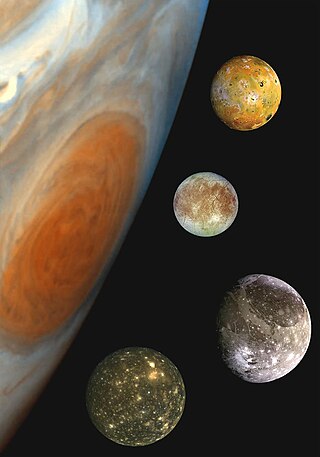
The Galilean moons, or Galilean satellites, are the four largest moons of Jupiter: Io, Europa, Ganymede, and Callisto. They are the most readily visible Solar System objects after the unaided visible Saturn, the dimmest of the classical planets, allowing observation with common binoculars, even under night sky conditions of high light pollution. The invention of the telescope enabled the discovery of the moons in 1610. Through this, they became the first Solar System objects discovered since humans have started tracking the classical planets, and the first objects to be found to orbit any planet beyond Earth.

Callisto, or Jupiter IV, is the second-largest moon of Jupiter, after Ganymede. In the Solar System it is the third-largest moon after Ganymede and Saturn's largest moon Titan, and as large as the smallest planet Mercury, though only about a third as massive. Callisto is, with a diameter of 4,821 km, roughly a third larger than Earth's Moon and orbits Jupiter on average at a distance of 1,883,000 km, which is about six times further out than the Moon orbiting Earth. It is the outermost of the four large Galilean moons of Jupiter, which were discovered in 1610 with one of the first telescopes, being visible from Earth with common binoculars.
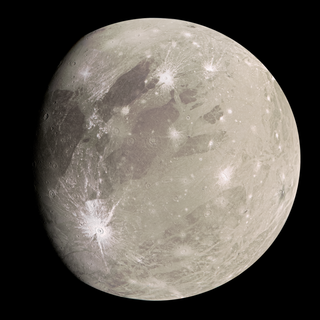
Ganymede, or Jupiter III, is the largest and most massive natural satellite of Jupiter and in the Solar System. It is the largest Solar System object without a substantial atmosphere, despite being the only moon in the Solar System with a substantial magnetic field. Like Titan, Saturn's largest moon, it is larger than the planet Mercury, but has somewhat less surface gravity than Mercury, Io, or the Moon due to its lower density compared to the three.
Here is a list of places on Earth, based on specific categories.
This is a directory of lists of geological features on planets excepting Earth, moons and asteroids ordered by increasing distance from the Sun.

Neith crater is a crater on Jupiter's moon Ganymede, the largest moon in the solar system.
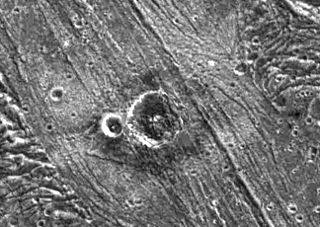
Nergal crater is a crater on Jupiter's moon Ganymede. It has a distinctive ejecta blanket surrounding it that's darker nearer the craters and brighter further away. The inner region of the ejecta is characterized by a lobate appearance indicative of the flow of a liquid substance over the surface. The flow was probably icy surface material melted by the energy released during the impact that formed the crater.
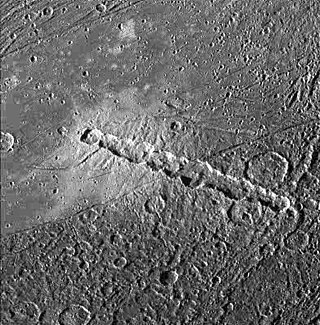
A crater chain is a line of craters along the surface of an astronomical body. The descriptor term for crater chains is catena, plural catenae, as specified by the International Astronomical Union's rules on planetary nomenclature.

USS Ganymede (AK-104) was a Crater-class cargo ship commissioned by the US Navy for service in World War II. She was responsible for delivering troops, goods and equipment to locations in the war zone. Named after the largest of the moons of Jupiter, Ganymede was the only ship of the Navy to bear this name.

Gula is a crater on Ganymede. It is a fresh crater with a distinctive central peak. It is about 40 km in diameter.

Achelous is a relatively fresh crater on Ganymede adjacent to the similarly sized Gula. It has an outer lobate ejecta deposit extending about a crater radius from the rim.

A palimpsest, in planetary astronomy, is an ancient crater that has been degraded over time. They may also be referred to as "ghost craters", "degraded craters", "buried craters", or "pathological craters". Palimpsests have been identified on Mercury, the Earth, the Moon, Mars, Ganymede, Callisto, and possibly even Titan. On Mars, these features are morphologically described as craters that are "flat-floored, rimless, extremely shallow, without central peaks, and would probably represent what remains after erosion."
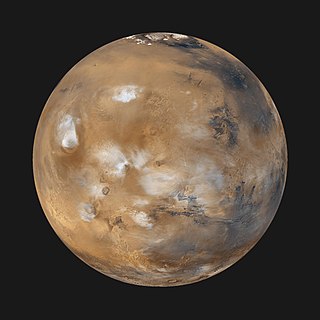
A low-aspect-ratio layered ejecta crater is a class of impact crater found on the planet Mars. This class of impact craters was discovered by Northern Arizona University scientist Professor Nadine Barlow and Dr. Joseph Boyce from the University of Hawaii in October 2013. Barlow described this class of craters as having a "thin-layered outer deposit" surpassing "the typical range of ejecta". "The combination helps vaporize the materials and create a base flow surge. The low aspect ratio refers to how thin the deposits are relative to the area they cover", Barlow said. The scientists used data from continuing reconnaissance of Mars using the old Mars Odyssey orbiter and the Mars Reconnaissance Orbiter. They discovered 139 LARLE craters ranging in diameter from 1.0 to 12.2 km, with 97% of the LARLE craters found poleward of 35N and 40S. The remaining 3% mainly traced in the equatorial Medusae Fossae Formation.
The following outline is provided as an overview of and topical guide to Jupiter: